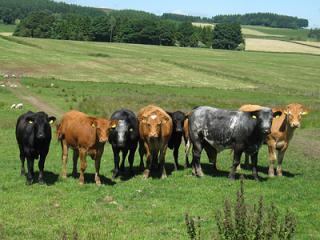Changing Farm Biosecurity Practices
Published on 10 February 2015 in Sustainability and Communities , Ecosystems and biodiversity , Food, health and wellbeing

Introduction
Scottish Government’s policy on disease control is that prevention is better than cure, however in practice this can be difficult to achieve. One of the strategies that farmers can adopt is to maximise farm biosecurity. This means minimising the probability that diseases can enter the farm for example, by home breeding instead of purchasing replacement livestock.
At the extreme, actions are taken to prevent all disease transmission routes, as during the 2001 UK outbreak of Foot and Mouth Disease (FMD), which can be very costly both to individual businesses and the wider economy. A risk based approach to selecting biosecurity measures to be put in place is therefore more usual, including both selection of the key diseases to be prevented and critical control points for them.
Due to a lack of data, farmers must make these risk assessments based on experience and the best available information, they are thus judgements where the outcomes are subject to uncertainty. Gaining insights into the judgements farmers make and in particular how changing government policy affects them can help in the development of future policy and improve animal health.
As part of a wider farm management project two farmer focus groups were undertaken to investigate biosecurity practices on cattle farms, how they had changed in recent years and the factors that had lead to those changes.
Key Points
- Farmers participating in the focus groups were alert to disease risks and were actively assessing them when making management decisions.
- Participants were reducing the numbers of purchased replacements (adopting closed herd policies). Many said they would now never purchase a replacement for a calf that died around birth.
- Where purchases were necessary there was a preference for buying replacements privately from known and trusted breeders. This was seen as a relatively safe practice as the farming community shared knowledge about poor practice and the reputational damage to a farmer caused by selling unhealthy animals would become well known and could have a detrimental impact on their business for many years.
- Short term market pressures mean that farmers can appear to behave inconsistently. For example, there is a preference to buy stock privately to reduce disease risks though a reluctance to sell stock in this way as there is a risk that the best market price will not be achieved.
- Compromises in biosecurity practices were sometimes necessary due to limited resources (e.g. labour and farm infrastructure)
- Three key factors were identified as having initiated or contributed to changing practice. These had roots in policy interventions and recent FMD outbreaks in GB, specifically:
- Trusted suppliers of replacement calves had been lost
- Knowledge of the likelihood of infections and their potential consequences had increased.
- SRDP funding had encouraged and facilitated veterinary promotion for health planning and diagnosis of infections.
- Breeding stock were perceived to be a significant capital investment that needed to be protected. Elimination of infections was costly and required a lot of effort. Once achieved the relaxation of biosecurity measures that prevented reinfection were considered unacceptable.
The two priority disease named by farmers for control were Johne’s disease and BVD (for which an eradication programme is currently underway in Scotland).
Research Undertaken
This research is part of a study investigating the management decisions of farmers that underlie observed behaviours. A key research focus was risk which is a well accepted characteristic of farming systems, though can be difficult for farmers and their advisors to quantify at the individual farm level. Two focus groups with 22 farmers were held to explore animal health management in depth and investigate changes in the management of disease risks.
Policy Implications
This study has highlighted the synergistic benefits of policy interventions that collectively address barriers to changing farm practice. It also draws attention to the importance of trusted knowledge brokers and knowledge circulation within the farming community. Time is required for knowledge transfer within these networks and for accepted new practices to become embedded in complex and highly individual farming systems.
Looking forward these findings suggest that government policy developments that support better practice and discourage poor practice will continue to be needed to encourage further improvements in farm animal disease control. Effective measures include those that impact directly on farms and those that effect change indirectly, through for example market developments. Specifically, monitoring of and support for critical elements of trusted information networks, such as regular interactions between farmers and veterinary surgeons could underpin better management of disease risks. In addition, research to better quantify disease risks could improve decisions.
Author
Dr Cath Milne, Future Farming Systems Group SRUC Cath.Milne@sruc.ac.uk
Topics
Sustainability and Communities , Ecosystems and biodiversity , Food, health and wellbeing







